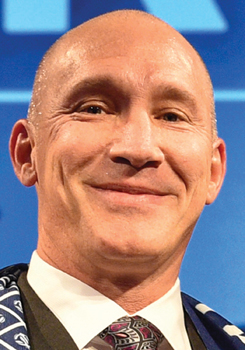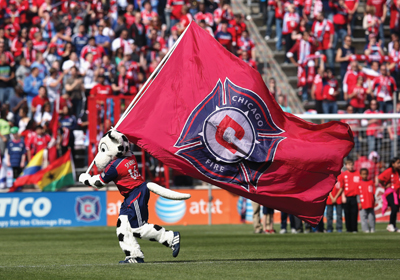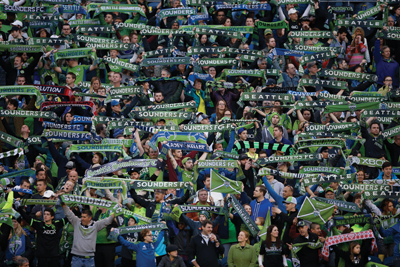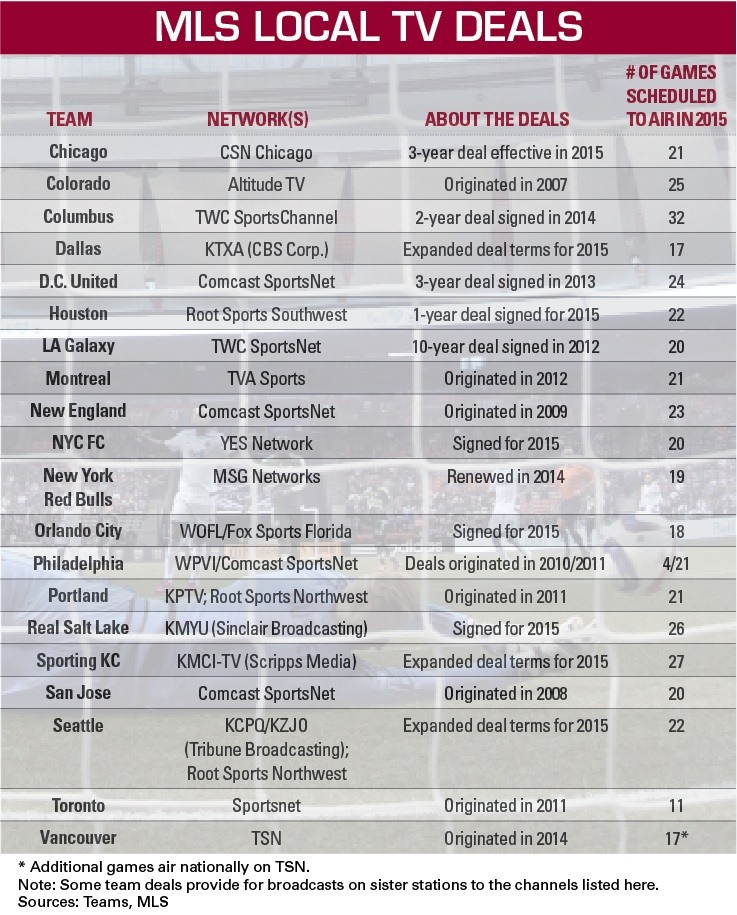When Real Salt Lake changed its local TV affiliation in 2012, the reason it made the switch was quite simple: Its broadcasts hadn’t been in HD, a no-go for a team that was infrequently on national television.
Prior to the start of the 2015 season, Real Salt Lake decided to sign back up with the channel it had walked away from three years ago — because of everything that former partner was now offering the team.
 |
Real Salt Lake’s new multiyear TV deal makes the games available in HD and covers production costs.
Photo by: GETTY IMAGES
|
“If you go throughout our history on television, we first had to pay to buy time plus cover the production. Then, we didn’t have to buy time but still covered production. Now, this new deal gives us both,” said Real Salt Lake President Bill Manning.
And they’re not alone. MLS as a league entered the 2015 season marking the first year of its new TV rights deals with ESPN, Fox and Univision, a landmark media package for the league not only in terms of increased revenue (five times the previous amount, up to $90 million on average annually from $18 million), but also in having a consistent, streamlined television schedule.
It is that momentum at the national level that has given MLS’s teams further impetus to upgrade their own local deals. That means aiming for upgrades like longer pregame and postgame shows and more frequent coverage outside of games, with additional shoulder programming.
 |
MANNING
|
Eight of MLS’s 20 teams in play this season are operating under new local TV deals that took effect this year, according to information on the deals provided by the teams and league.
In Utah, Real Salt Lake’s new multiyear deal with Sinclair Broadcasting, which acquired the team’s former partner station, KMYU, and sister station KUTV in 2012, makes the team’s games available in HD and covers the production costs for the broadcasts. That’s the first time the club itself hasn’t had to handle production, providing what Manning characterized as a “significant” cost savings, though he declined to share specifics.
The deal is helping the team spread its footprint as well. The team’s 26 regionally televised games will air on KMYU’s free, over-the-air HD station that reaches all 1.6 million homes across Utah. Sinclair also has reached syndication agreements with stations in Boise, Idaho, and in Las Vegas and Reno, Nev., to carry matches. It expects similar deals with stations in Albuquerque, Phoenix and Tucson, Ariz., in the weeks ahead, giving Real Salt Lake exposure to more than 5.5 million homes in the region — distribution that is similar to larger regional deals signed by teams such as Seattle, Portland and Los Angeles.
 |
The Fire’s new TV deal with Comcast puts it alongside other pro teams in Chicago.
Photo by: GETTY IMAGES
|
The increased exposure in turn provides the team further opportunities for sponsorship and advertising, and added recognition for its players, Manning said.
“When you put all of that together, this deal was almost a no-brainer,” he said. “Even being in a smaller market, we can still make some big noise regionally.”
In Chicago, the Fire used MLS’s new national TV lineup as a blueprint of sorts for its own new deal. Team executives saw a need to establish itself with a network that offers more than just linear TV.
“Historically, we’ve always done year-by-year deals, which is fine, but in order to build destination programming, we need that consistency,” said Fire President Atul Khosla. “When we started our talks with Comcast, we stressed that we obviously wanted quality coverage for the 90 minutes of the match, but also a partnership that was more complex than that — a full package that helps us engage with the fans.
“We wanted to be part of the year-round sports discussion in Chicago, and we had that dialogue with the highest levels at Comcast, which turned into a new three-year deal,” Khosla said.
The Fire’s previous broadcaster partner was WPWR/My50 Chicago, part of the Fox Television Stations group. The team declined to comment on financial details of its current or previous deals, but Fire executives like the fact that the Comcast deal puts the Fire alongside all the other pro teams in Chicago. It’s also a development that pushed the club to improve its game productions. The team has added a full-time in-house video department, something Khosla said the team stressed to Comcast would also help to provide exclusive content and behind-the-scenes footage to further engage fans.
“The aim is to have year-round coverage around the team so that even when the game is not on, we’re still able to engage with both our fans and the corporate community,” he said. “Chicago is an incredibly competitive sports landscape, so it was a key goal to be in that conversation with all the pro teams, and hanging out at the same place as the rest of them is a big part of that.”
There are, however, some MLS teams that still have measurable room for growth with their local TV packages.
Expansion Orlando City SC’s one-year deal with FS Florida, for example, carries no rights fee. It is a barter deal, with the team handling both game production and advertising.
It’s a similar situation in Washington, D.C., where Comcast SportsNet Mid-Atlantic does not pay a rights fee for D.C. United games, though the Comcast RSN handles game production and advertising. Last season, D.C. United games on CSN Mid-Atlantic averaged only a 0.3 rating/7,000 homes, far behind CSN’s viewer numbers for the NBA Wizards and NHL Capitals. This season, the Wizards are averaging a 1.4 rating, and the Capitals are averaging a 1.1 rating.
But in only the league’s 20th season and with many MLS teams being even younger than that, the path to local television success seems to be out there for the taking as the teams continue to grow.
“In fairness, the networks have to be prudent. When we came in the league in 2009, no one knew what we would have here,” said Seattle Sounders COO Bart Wiley. “But as our brand matured and our fan base expanded, we were able to show to TV partners that this was a consistent and growing organization that really captured the interest of sports fans in Seattle.”
 |
The Sounders saw a 32 percent year-over-year viewership increase for the 2014 season.
Photo by: GETTY IMAGES
|
The Sounders capped off their 2014 season with a 32 percent increase in year-over-year viewership, according to the team, and Seattle boasts the top local ratings leaguewide. It’s that success that aided the team in signing new multiyear deals prior to this season with local television partners Q13 Fox (KCPQ) and JOEtv (KZJO), both owned by Tribune Broadcasting.
The Sounders also signed a multiyear regional deal with Root Sports to bring the team’s broadcasts throughout Washington, Oregon, Idaho, Montana and Alaska. The team declined to disclose additional financial details of the deals.
The Sounders will see an increase in shoulder programming, as well, including an expanded 30-minute postmatch wrap-up, two 30-minute team specials during 2015, and a weekly segment during the daily sportscast on its local partner stations. There also will be a new magazine-style show on the Root Sports outlet that will air twice a month, providing further depth and access into the club.
“Now we’re able to show these networks that we believe there are compelling reasons to have more content, and here are the metrics and math that support that,” Wiley said. “A lot of that credit goes right back to our fan base, as they are the ones that help to make the atmosphere in the stadium so compelling.”
From the league’s perspective, it’s simply a matter of momentum, said MLS Business Ventures President and Managing Director Gary Stevenson.
“We see improvements in media and content distribution as products of momentum,” he said. “We have momentum on our national and domestic deals, international deals, and now you’re seeing much improved momentum at the local level as well.”
“If you put that all together,” he said, “that’s how leagues grow.”
 |
Photo by: GETTY IMAGES
|








